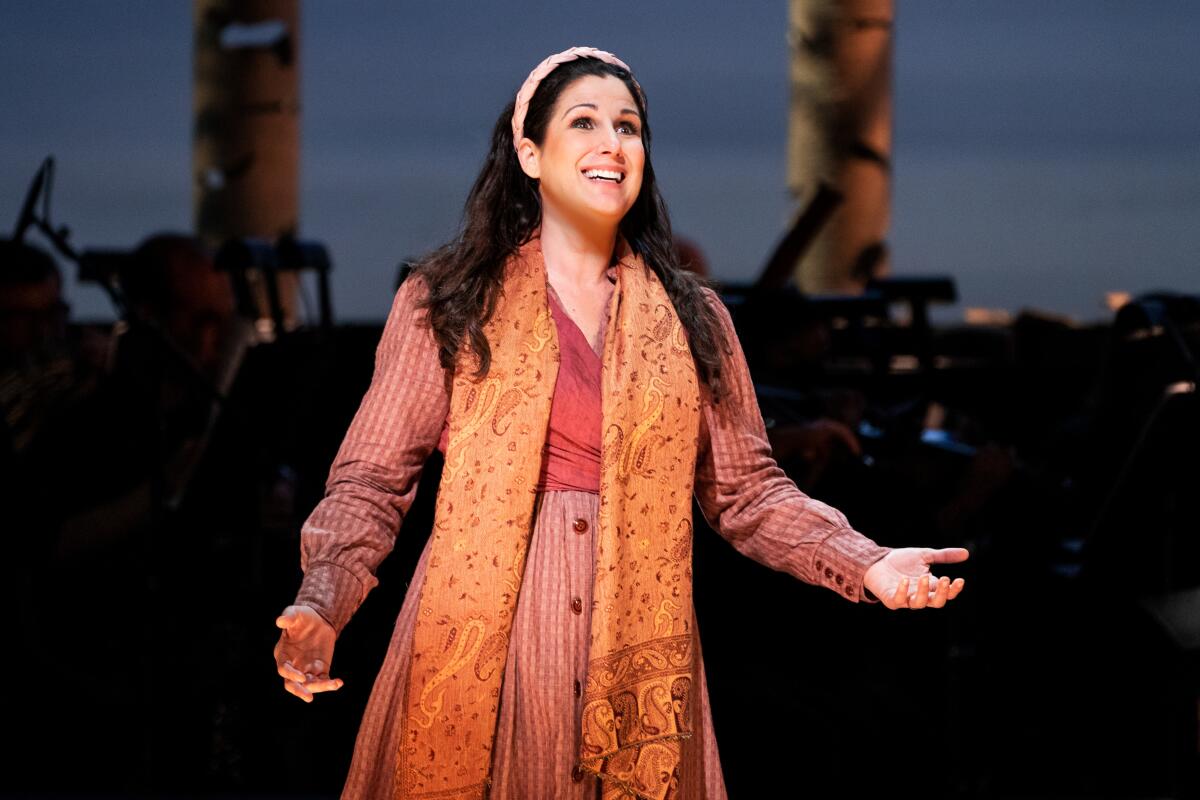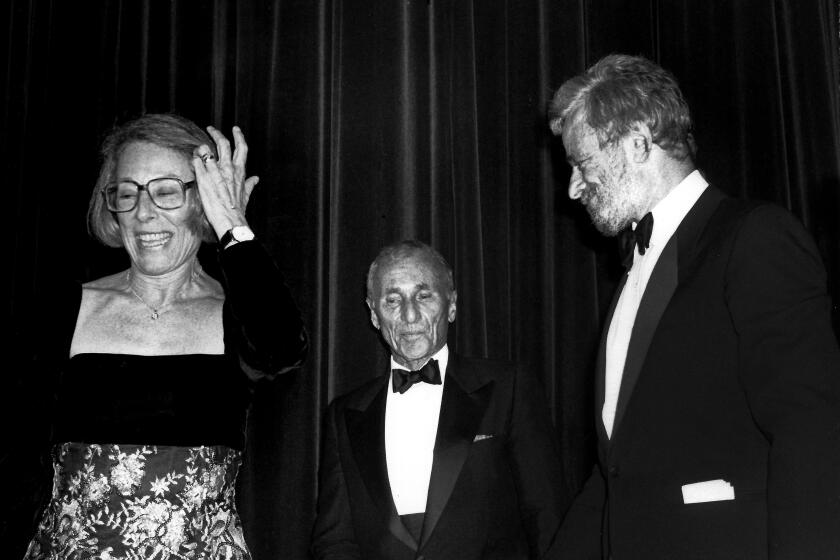What a difference a revival makes: Two famously tricky Sondheim musicals shine in new outings

- Share via
NEW YORK — At lunch recently in New York with a retired theater critic, I asked if he’d care to join me later in the week for a matinee of the touted Broadway revival of “Into the Woods.” No, he demurred. He had reviewed the original production, and the show, like many of Stephen Sondheim’s musicals, has a second act problem.
My distinguished colleague, whom I’ve long considered a mentor, was making decisions based on his energy and interest during the busy holiday period. He longed to be my plus-one for “Merrily We Roll Along,” a Sondheim musical with a notorious track record in the theater, so it isn’t as though he’s averse to recalcitrant material. (That ticket — the hottest in New York for the New York Theatre Workshop production starring Daniel Radcliffe, Jonathan Groff and Lindsay Mendez — was already claimed.)
But his reason for passing on “Into the Woods” made me reflect on critics and their relationship to their own criticism. Of course there are shows that I’ve panned that wild horses couldn’t drag me to see again. But I feel no need to stay true to my published verdicts, especially with works that have a long afterlife.
To be faithful to what I wrote several decades ago would be to betray who I am today. Not only do individuals change, but culture does as well. Art moves kaleidoscopically as new work alters our perception of what has come before and shifting societal norms unearth new sensitivities and blind spots.
In the theater, where ephemerality is built into the show, flux is the only constant. Not only does each new revival of “Hamlet” offer its own spin on the tragedy, but no two performances of even the same production are identical. Every time I encounter the play, I can’t help experiencing aspects of the plot and poetry anew.
What’s true for Shakespeare also holds for mere mortal playwrights. A gifted performer can endow even a flimsy role with gravitas. And the right director has been known to summon coherence where previously only chaos had existed.
What a difference a revival can make! I have long worshiped at the shrine of Henrik Ibsen’s dramatic genius, but I recall muttering to myself after a ponderous regional theater production of “A Doll’s House” that this landmark drama was perhaps too creaky for the modern stage. I couldn’t see beyond the mechanical plotting until a few weeks later I caught Janet McTeer’s towering portrayal of Nora in Anthony Page’s fearless 1997 Broadway revival and declared Ibsen’s masterwork to be the freshest play on Broadway.
But it’s not just a matter of the collaborative personnel. We transform as much as productions do. Why is it that a film that previously annoyed us can sometimes sneak its way into our affections on subsequent viewing?
I’m a great admirer of the mid-20th century English novelist Elizabeth Taylor (sometimes referred to as “the other Elizabeth Taylor”), but I found it difficult to crack her short stories, which are considered some of her finest writing. Last year, however, I devoured “You’ll Enjoy It When You Get There: The Stories of Elizabeth Taylor,” a reading experience that was perhaps the aesthetic pinnacle of my year.
As a child I was an extremely fussy eater, and my defiant stubbornness would provoke loud dinner table scenes. My father vowed that one day I would finally taste the dish I had been avoiding and regret all those years I had passed it up. I can’t say I ever felt that way about asparagus, but his words did haunt me after I finished Taylor’s brilliant collection of short fiction.
A critic’s tribute to Broadway composer and lyricist Stephen Sondheim, a master of storytelling in song.
Criticism is the art of refining first impressions into second thoughts, which Merriam-Webster defines as “reconsideration or a revised opinion of a previous often hurried decision.” Reviewers leave a show with questions and feelings that find clarity and conviction only through the painstaking act of writing.
Years of composing reviews on tight deadlines have made apparent to me the fluidity of critical judgment. It’s not that I often radically reverse course, but the weighing of perceived strengths and weaknesses into published assessments can make the process seem more mathematical than it really is.
Art doesn’t ask us to solve equations. Rather, it invites us to immerse ourselves in another sensibility. We’re given the opportunity to look at a world through a unique lens that may take some adjusting to but is intended to sharpen our vision of our more prosaic lives.
Work that endures bears repeat viewing. If different generations can find something of value in a play or musical, chances are there’s more there than can be assimilated in a single outing. As a critic, I’m aware that my understanding of a piece isn’t fixed. I may continue to focus on shortcomings. But when faults are known in advance, virtues sometimes have an opportunity to better introduce themselves.
“Into the Woods” doesn’t have a second act problem, but it is a long musical. James Lapine’s book could use some slimming, but I hardly minded because for nearly three hours, as the temperature fell in New York to close to zero degrees, I was in the heat of ecstasy.

The production, which began at New York’s Encores! last May, has been going strong since it opened at Broadway’s St. James Theatre in August. The revolving door ensemble has included a number of musical theater heavyweights. But credit must go to director Lear deBessonet, who has created a canvas both flexible enough and controlled enough to allow the performers to boldly make the roles their own.
I’m thrilled that two of the standouts in the cast I saw (Stephanie J. Block as the Baker’s Wife and Gavin Creel as Cinderella’s Prince and the Wolf) will be traveling with the production when it comes to the Ahmanson Theatre in June. I will miss the understated hilarity of Brian d’Arcy James as the Baker, but I am thrilled that Katy Geraghty as a knife-wielding Little Red Ridinghood will be frolicking to grandmother’s house with her acerbic humor intact.

Truth be told, I haven’t always loved “Into the Woods,” which was originally produced at the Old Globe in 1986. Rob Marshall’s 2014 film floundered despite (or perhaps because of) its embarrassment of Hollywood riches. But when the pieces come together, as they did at the Hollywood Bowl in Robert Longbottom’s 2019 production, the spell of even the second act remains unbroken.
2023 already seems brighter knowing that DeBessonet’s production will be bringing its enchantment to the Ahmanson in June. I’m also happy to report that Maria Friedman’s Broadway-bound production of “Merrily We Roll Along,” a Sondheim musical with a tricky reverse-chronology book by George Furth, succeeds where other stagings have failed.

This unmerry track record includes the revival that Friedman herself directed in London. That production, which started at the Menier Chocolate Factory in 2012, seemed lost when I saw it the following year in the West End at the Harold Pinter Theatre. I had more or less given up hope on anyone solving the problem of “Merrily,” even though the music and the meditation on middle-age malaise have long gripped my soul.
How did Friedman finally manage to figure out this musical puzzle in New York? My answer is Jonathan Groff, whose performance as Franklin Shepard, the once idealistic, golden boy composer who wonders how he sold his soul for Hollywood success, stands beside Lea Michele’s performance in “Funny Girl” as the most deeply inhabited tour de force of 2022.
But another respected theater critic colleague cogently argued over lunch that the production’s key performance is Mendez’s Mary Flynn, the wisecracking, heavy-drinking writer whose unrequited love for Franklin destroys something inside of her. And on Facebook, many discerning commentators are touting the excellence of Radcliffe’s Charley Kringas, the lyricist whose disillusionment over what’s happened to his writing partner, Franklin, matches Mary’s more personal grief.
The triangle, it must be said, is beautifully balanced, but Groff for me is the emotional hypotenuse of a production that I can’t wait to see again after it moves to Broadway in the fall. How will I feel about the revival nearly a year later in a less intimate venue? Who can say? But part of the excitement of repeat theatergoing is not knowing how something overlooked might reach deep into your heart and detonate new meaning.
D.T. Max’s “Finale,” about Sondheim, and “Shy,” by Mary Rodgers and Jesse Green, bring the singular Broadway personalities back to life.
More to Read
The biggest entertainment stories
Get our big stories about Hollywood, film, television, music, arts, culture and more right in your inbox as soon as they publish.
You may occasionally receive promotional content from the Los Angeles Times.













